Abstract
Electron transport components involved in H2 oxidation were studied in membranes from Rhizobium japonicum bacteroids. Hydrogen oxidation in membranes was inhibited by antimycin A and 2-n-heptyl-4-hydroxyquinoline-N-oxide with Ki values of 39.4 and 5.6 microM, respectively. The inhibition of H2 uptake by cyanide was triphasic with Ki values of 0.8, 9.9, and 93.6 microM. This result suggested that three cyanide-reactive components were involved in H2 oxidation. H2-reduced minus O2-oxidized absorption difference spectra showed peaks at 551.5 and 560 nm, indicating the involvement of c- and b-type cytochromes, respectively. This spectrum also revealed a trough at 455 nm, showing that H2 oxidation involves a flavoprotein. This flavoprotein was not reduced by H2 in the presence of cyanide. The inhibition of H2 or cytochrome c oxidation by the flavoprotein inhibitor Atebrin was monophasic; the Ki values were similar for both substrates. A role for the flavoprotein as a terminal oxidase was implicated based on its high redox potential and its sensitivity to cyanide. Cytochromes o and c-552 were identified based on their ability to bind carbon monoxide and cyanide.
Full text
PDF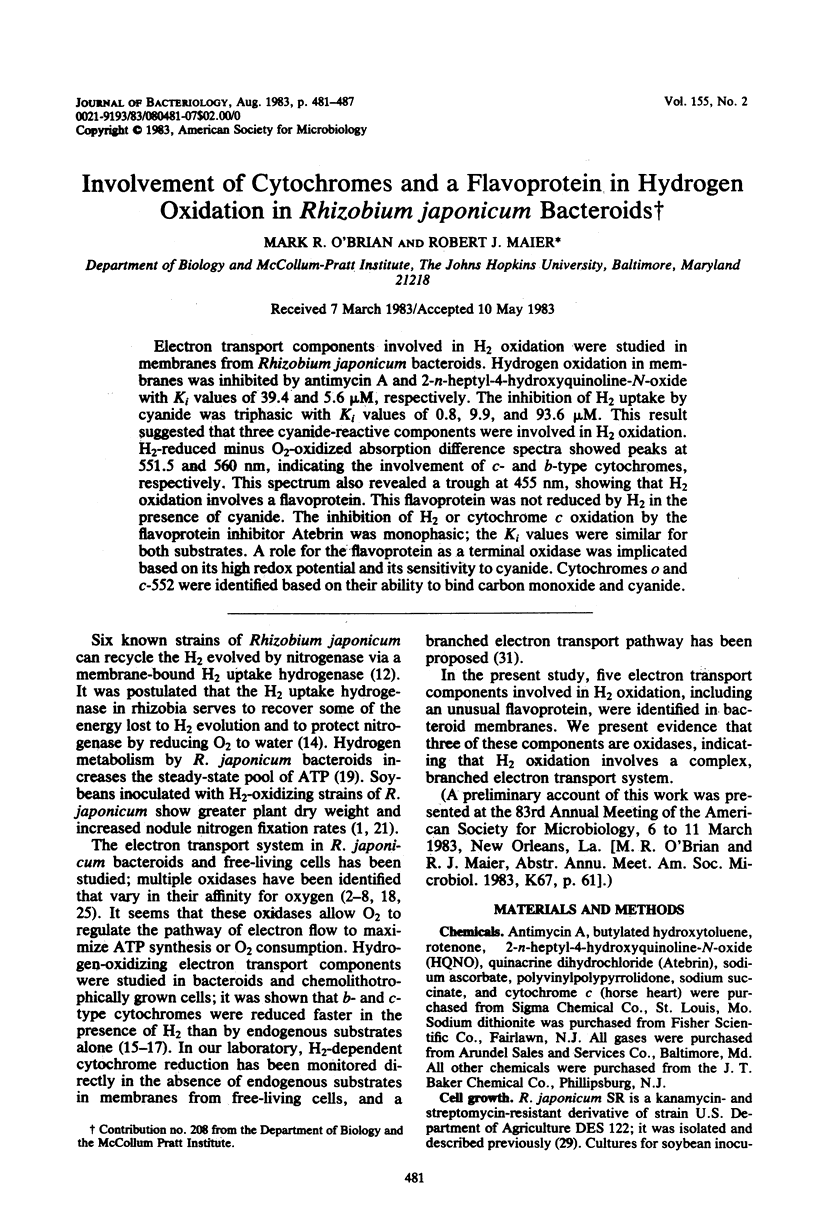
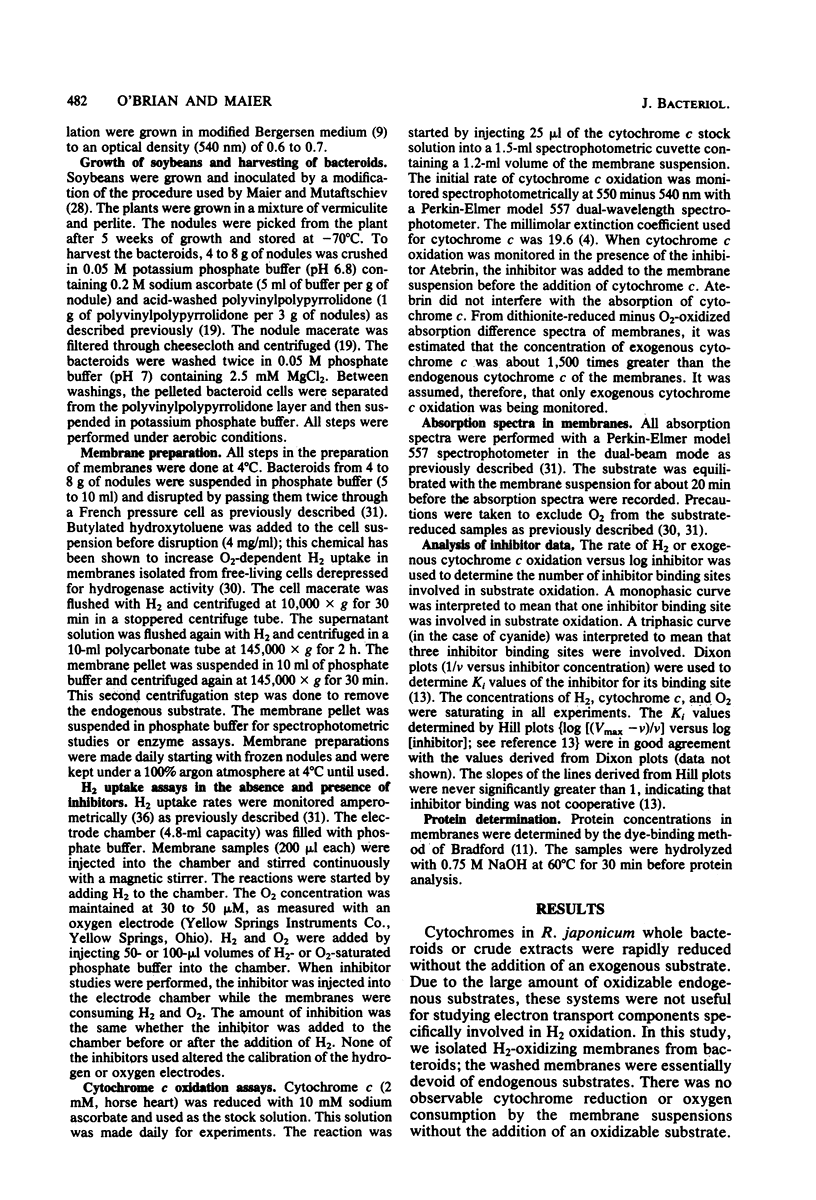
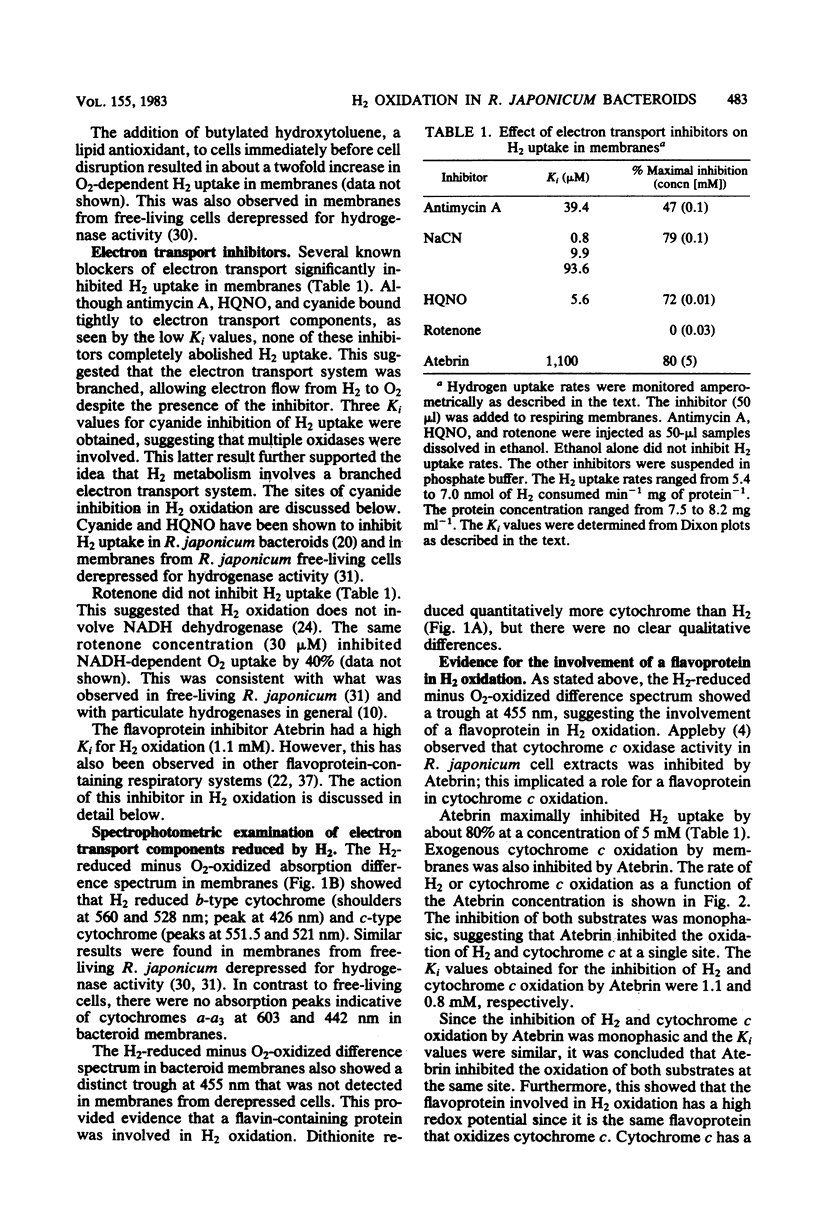
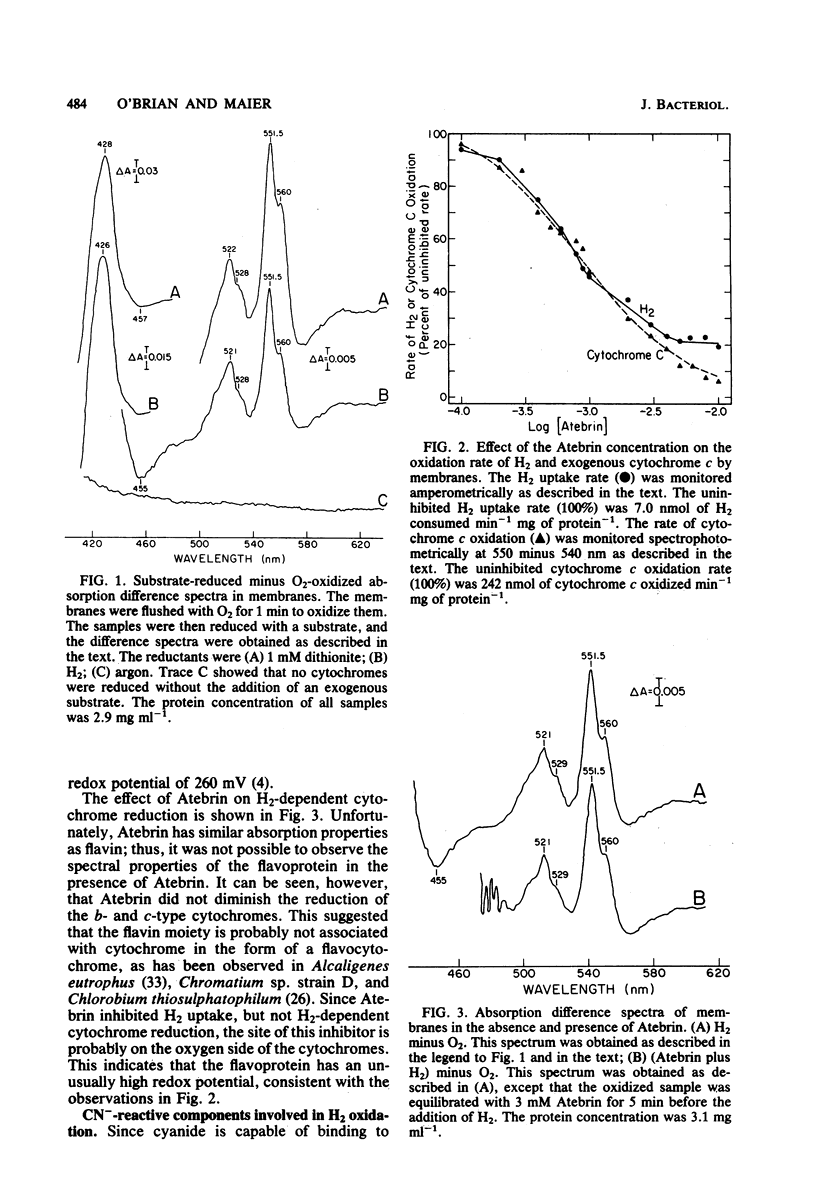
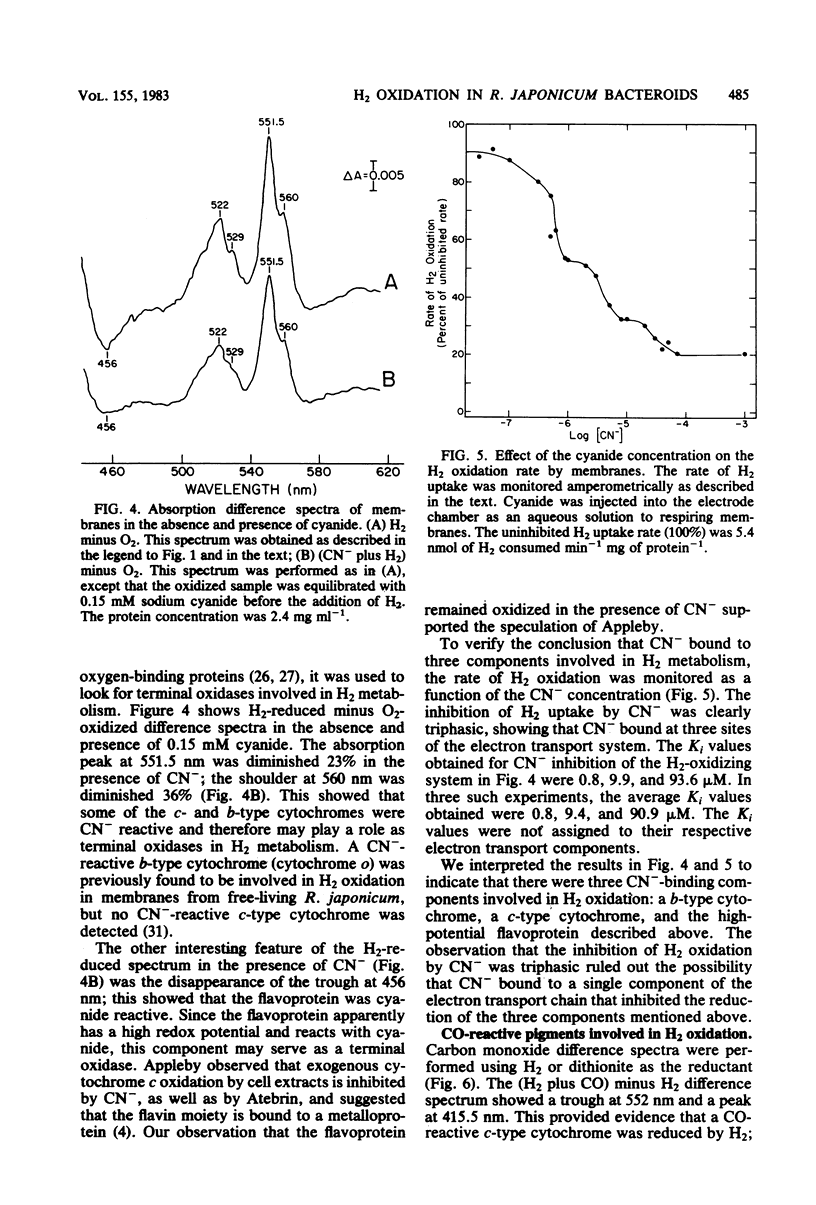
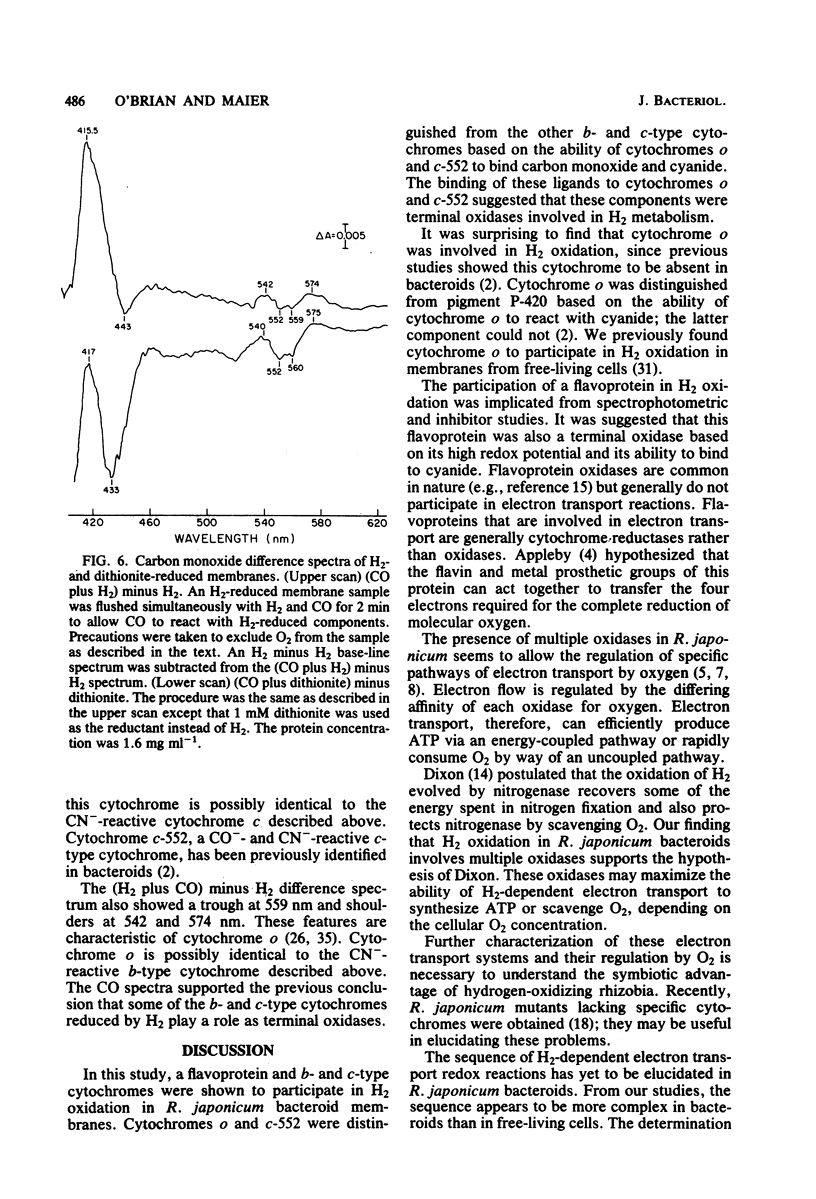
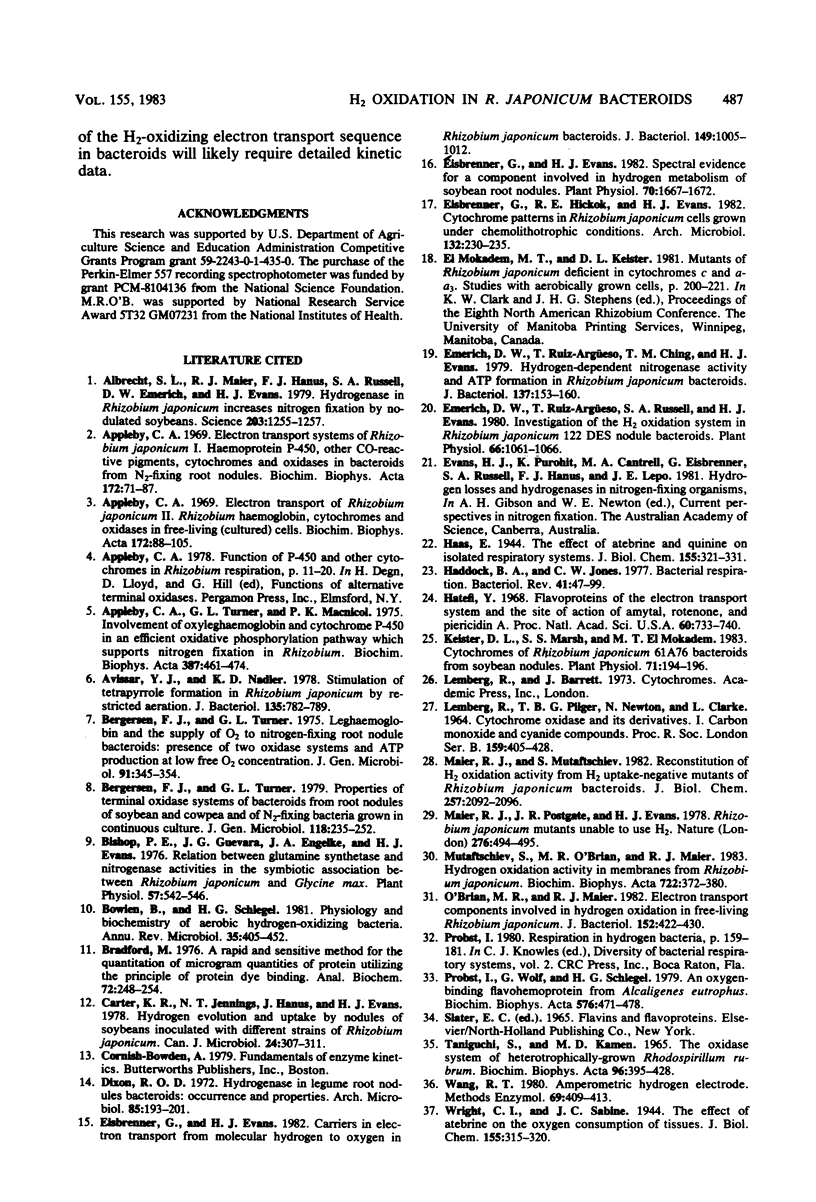
Selected References
These references are in PubMed. This may not be the complete list of references from this article.
- Albrecht S. L., Maier R. J., Hanus F. J., Russell S. A., Emerich D. W., Evans H. J. Hydrogenase in Rhizobium japonicum Increases Nitrogen Fixation by Nodulated Soybeans. Science. 1979 Mar 23;203(4386):1255–1257. doi: 10.1126/science.203.4386.1255. [DOI] [PubMed] [Google Scholar]
- Appleby C. A. Electron transport systems of Rhizobium japonicum. I. Haemoprotein P-450, other CO-reactive pigments, cytochromes and oxidases in bacteroids from N2-fixing root nodules. Biochim Biophys Acta. 1969 Jan 14;172(1):71–87. doi: 10.1016/0005-2728(69)90093-0. [DOI] [PubMed] [Google Scholar]
- Appleby C. A. Electron transport systems of Rhizobium japonicum. II. Rhizobium haemoglobin, cytochromes and oxidases in free-living (cultured) cells. Biochim Biophys Acta. 1969 Jan 14;172(1):88–105. doi: 10.1016/0005-2728(69)90094-2. [DOI] [PubMed] [Google Scholar]
- Appleby C. A., Turner G. L., Macnicol P. K. Involvement of oxyleghaemoglobin and cytochrome P-450 in an efficient oxidative phosphorylation pathway which supports nitrogen fixation in Rhizobium. Biochim Biophys Acta. 1975 Jun 17;387(3):461–474. doi: 10.1016/0005-2728(75)90086-9. [DOI] [PubMed] [Google Scholar]
- Avissar Y. J., Nadler K. D. Stimulation of tetrapyrrole formation in Rhizobium japonicum by restricted aeration. J Bacteriol. 1978 Sep;135(3):782–789. doi: 10.1128/jb.135.3.782-789.1978. [DOI] [PMC free article] [PubMed] [Google Scholar]
- Bergersen F. J., Turner G. L. Leghaemoglobin and the supply of O2 to nitrogen-fixing root nodule bacteroids: presence of two oxidase systems and ATP production at low free O2 concentration. J Gen Microbiol. 1975 Dec;91(2):345–354. doi: 10.1099/00221287-91-2-345. [DOI] [PubMed] [Google Scholar]
- Bishop P. E., Guevara J. G., Engelke J. A., Evans H. J. Relation between Glutamine Synthetase and Nitrogenase Activities in the Symbiotic Association between Rhizobium japonicum and Glycine max. Plant Physiol. 1976 Apr;57(4):542–546. doi: 10.1104/pp.57.4.542. [DOI] [PMC free article] [PubMed] [Google Scholar]
- Bowien B., Schlegel H. G. Physiology and biochemistry of aerobic hydrogen-oxidizing bacteria. Annu Rev Microbiol. 1981;35:405–452. doi: 10.1146/annurev.mi.35.100181.002201. [DOI] [PubMed] [Google Scholar]
- Bradford M. M. A rapid and sensitive method for the quantitation of microgram quantities of protein utilizing the principle of protein-dye binding. Anal Biochem. 1976 May 7;72:248–254. doi: 10.1016/0003-2697(76)90527-3. [DOI] [PubMed] [Google Scholar]
- Carter K. R., Jennings N. T., Hanus J., Evans H. J. Hydrogen evolution and uptake by nodules of soybeans inoculated with different strains of Rhizobium japonicum. Can J Microbiol. 1978 Mar;24(3):307–311. doi: 10.1139/m78-051. [DOI] [PubMed] [Google Scholar]
- Eisbrenner G., Evans H. J. Spectral evidence for a component involved in hydrogen metabolism of soybean nodule bacteroids. Plant Physiol. 1982 Dec;70(6):1667–1672. doi: 10.1104/pp.70.6.1667. [DOI] [PMC free article] [PubMed] [Google Scholar]
- Emerich D. W., Ruiz-Argüeso T., Ching T. M., Evans H. J. Hydrogen-dependent nitrogenase activity and ATP formation in Rhizobium japonicum bacteroids. J Bacteriol. 1979 Jan;137(1):153–160. doi: 10.1128/jb.137.1.153-160.1979. [DOI] [PMC free article] [PubMed] [Google Scholar]
- Emerich D. W., Ruiz-Argüeso T., Russell S. A., Evans H. J. Investigation of the H(2) Oxidation System in Rhizobium japonicum 122 DES Nodule Bacteroids. Plant Physiol. 1980 Dec;66(6):1061–1066. doi: 10.1104/pp.66.6.1061. [DOI] [PMC free article] [PubMed] [Google Scholar]
- Haddock B. A., Jones C. W. Bacterial respiration. Bacteriol Rev. 1977 Mar;41(1):47–99. doi: 10.1128/br.41.1.47-99.1977. [DOI] [PMC free article] [PubMed] [Google Scholar]
- Hatefi Y. Flavoproteins of the electron transport system and the site of action of amytal, rotenone, and piericidin A. Proc Natl Acad Sci U S A. 1968 Jun;60(2):733–740. doi: 10.1073/pnas.60.2.733. [DOI] [PMC free article] [PubMed] [Google Scholar]
- Keister D. L., Marsh S. S., El Mokadem M. T. Cytochromes of Rhizobium japonicum 61A76 Bacteroids from Soybean Nodules. Plant Physiol. 1983 Jan;71(1):194–196. doi: 10.1104/pp.71.1.194. [DOI] [PMC free article] [PubMed] [Google Scholar]
- LEMBERG R., PILGER T. B., NEWTON N., CLARKE L. CYTOCHROME OXIDASE AND ITS DERIVATIVES. I. CARBON MONOXIDE AND CYANIDE COMPOUNDS. Proc R Soc Lond B Biol Sci. 1964 Feb 18;159:405–428. doi: 10.1098/rspb.1964.0010. [DOI] [PubMed] [Google Scholar]
- Maier R. J., Mutaftschiev S. Reconstitution of H2 oxidation activity from H2 uptake-negative mutants of Rhizobium japonicum bacteroids. J Biol Chem. 1982 Feb 25;257(4):2092–2096. [PubMed] [Google Scholar]
- O'Brian M. R., Maier R. J. Electron transport components involved in hydrogen oxidation in free-living Rhizobium japonicum. J Bacteriol. 1982 Oct;152(1):422–430. doi: 10.1128/jb.152.1.422-430.1982. [DOI] [PMC free article] [PubMed] [Google Scholar]
- Probst I., Wolf G., Schlegel H. G. An oxygen-binding flavohemoprotein from Alcaligenes eutrophus. Biochim Biophys Acta. 1979 Feb 26;576(2):471–478. doi: 10.1016/0005-2795(79)90422-7. [DOI] [PubMed] [Google Scholar]
- TANIGUCHI S., KAMEN M. D. THE OXIDASE SYSTEM OF HETEROTROPHICALLY-GROWN RHODOSPIRILLUM RUBRUM. Biochim Biophys Acta. 1965 Mar 22;96:395–428. doi: 10.1016/0005-2787(65)90560-5. [DOI] [PubMed] [Google Scholar]


